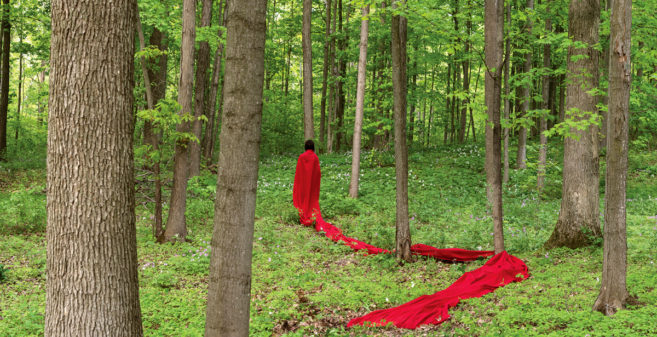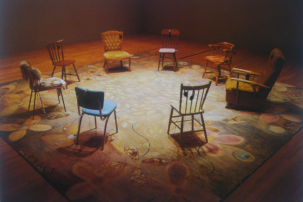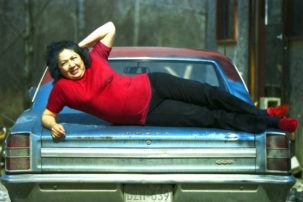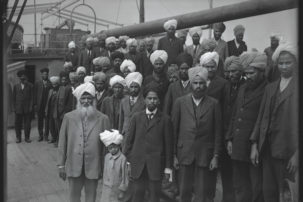The winners of the 2019 Governor General’s Awards in Visual and Media Arts were released early this morning. In total, seven artists and one curator are being honoured.
The media the winners work in vary widely—from glass art to boreal-forest poetry to nationwide billboard exhibitions. And the themes they have addressed span a wide range as well, including residential-school injustices, AIDS impacts, the Komagata Maru incident, and more.
All winners receive $25,000 each, as well as a bronze medallion to be presented in a March 28 ceremony at Rideau Hall in Ottawa. As is customary, the winners will also have their work exhibited at the National Gallery of Canada in coming months. And short films about each artist will be on view soon on the entertainment systems for Air Canada flights and VIA Rail journeys.
(A note regarding juries: The peer assessment committee for the Saidye Bronfman Prize this year included Corrine Hunt, Denis Longchamps, Marcel Marois and Alexandra McCurdy. The peer assessment committee for the Artistic Contribution and Lifetime Artistic Achievement Awards this year included Colleen Cutschall, Andrea Fatona, Michael Fernandes, Carlos Ferrand, Isabelle Hayeur and Kevin Schmidt.)
Here are the winners of the 2019 Governor General’s Awards in Visual and Media Arts:
Jeff Thomas
Ottawa-based artist Jeff Thomas has long used photography to address how Indigenous people are pictured in Western art history. His Indians on Tour series, ongoing since 2000, consists of photographs in which small gift-shop-style figurines of Indigenous people are posed within wider landscapes in North America in Europe. Thomas’ expansive practice has also addressed his own family photographs old and new, as well as documented (and intervened in) the ways Indigenous people are represented in public art. In 2014/2015 Thomas curated the exhibition “Where Are the Children? Healing the Legacy of Residential Schools,” an archival-photo show at the Glenbow Museum in Calgary.
Lee-Ann Martin
In 2018, independent curator Lee-Ann Martin made international headlines when she curated “Resilience,” a nationwide billboard exhibition featuring art by Indigenous women artists. “For too long, ‘big art’ has been thought to be the domain of white, Western male artists,” Martin wrote in her curatorial essay. “This project presents the work of Indigenous women artists writ LARGE, with significant physical presence that cannot be ignored or erased.” Martin has worked in the curatorial field for decades; among her notable projects is the co-curation, with Gerald McMaster, of “Indigena: Perspectives of Indigenous Peoples on 500 Years,” which was on view at the Canadian Museum of Civilization in 1992 and toured to other venues in the US and Canada. More recently, Martin wrote the essay “Anger & Reconciliation: A Very Brief History of Exhibiting Contemporary Indigenous Art in Canada” in the Summer 2017 issue of Afterall. Martin receives the Outstanding Contribution award of this year’s GGs.
Stephen Andrews
Stephen Andrews lives in Toronto. As Andrews puts it in an online artist statement, “Generally there is a news story behind a given body of work, be that AIDS, war or advances in surveillance technologies. The ideas embodied in these stories are like irritants and the work accretes around them like pearls. The various ‘looks’ of mechanical reproduction: digital, the dot matrix in print reproduction, film or television technologies are rendered by hand in an attempt to represent both the message and the means by which it is delivered.” Andrews’ striking work is currently the subject of a solo exhibition titled “Aftermath” at the McMichael Collection in Kleinberg; it continues there to February 18. Andrews was nominated by Jessica Bradley and Marnie Fleming.
Ali Kazimi
Before Toronto-based filmmaker Ali Kazimi released his feature film Continuous Journey in 2004, relatively few Canadians were aware of the Komagata Maru incident. In that 1914 incident, 352 passengers of 376 on a ship from Punjab were denied entry to Canada—part of a systematic governmental effort to keep people from India out of the country. After the film was released, it received many critical accolades and toured widely, gradually raising awareness both domestically and internationally about this issue. In 2012, Kazimi also authored the book Undesirables: White Canada and the Komagata Maru – An Illustrated History, which was published by Douglas & McIntyre in 2012 and was a finalist for the City of Vancouver Book Award. Kazimi’s other acclaimed films include Shooting Indians, a 1997 look at the work of fellow 2019 GG winner Jeff Thomas, and Random Acts of Legacy, an award-winning 2016 film that was sparked by found footage of a Chinese American family’s early home moves. Kazimi was nominated by Karen Tisch.
Marlene Creates
Since 2002, most of Marlene Creates’ art has been based in a six-acre patch of boreal forest surrounding her home in Portugal Cove, Newfoundland and Labrador. What she now calls The Boreal Poetry Garden (2005–) is frequently home to text-based artworks, poetry readings and guided art walks, as well as serving as an inspiration or matrix for photographs and other visual artworks. For instance, her series What Came to Light at Blast Hole Pond River (2015–) is formed from photographs of local wildlife taken by a motion-triggered trail camera. A survey of her work, “Marlene Creates: Places, Paths, and Pauses” is currently touring and due to appear at the Carleton University Art Gallery from May 21 to August 25, 2019, and at the Rooms from October 12, 2019, to January 19, 2020. Creates was nominated by Anne Chafe, Mireille Eagan, and Melony Ward.
Susan Edgerley
This year’s Saidye Bronfman Award at the GGs, honouring fine craft artistry, goes to Susan Edgerley. Based in Val-Morin, Edgerley is known not only for her large-scale installations in the challenging medium of glass, but also for her leadership in teaching glass arts in Canada. She began as a teacher at Sheridan College in the mid-1980s, moving from there in the late 1980s to establish Quebec’s first college-level glass arts program at Espace Verre, which operates in partnership with Cégep du Vieux Montréal. In the early 1990s, she also established Quebec’s first postgraduate transitional hot-glass studio program there. Her work has been part of more than 200 exhibitions in Canada, USA, England, France, Finland, Germany, South Korea and Hong Kong. Edgerley was nominated by Christian Poulin.
Andrew James Paterson
Andrew James Paterson, another GG recipient this year, has a broad, complex body of work encompassing writing, editing, performance, music, curation, filmmaking and more. One of the Toronto artist’s recent books, Collection Correction, was published in 2016 by Kunstverein Toronto and Milan’s Mousse. Another, Not Joy Division, was published in 2018 by Toronto’s Impulse B. A few months ago, a Berlin launch for both books was held at Motto. In 2001, Paterson co-edited the book Money, Value, Art with Sally McKay. Paterson received a spotlight at the Festival international du film sur l’art in Montreal in 2017. In an interview for FIFA, he stated, “Except for audio art and a lot of writing and then some music, art is visual. There must be something to look at or imagine the look of. And so much of the writing I enjoy is about words as images, or how they play on initially blank pages…pages are canvases, right?”
COZIC
Last but not least, COZIC is another recipient of the Governor General’s Award in Visual and Media Arts this year. This duo, comprised since the 1960s of Monic Brassard and Yvon Cozic, is based in Sainte Anne-de-la-Rochelle, Quebec. COZIC’s interdisciplinary and collaborative practice has been featured in roughly 50 solo exhibitions and more than 200 group exhibitions. Public artworks include 1988’s Hommage in Longeuil, Quebec; this work resembles a large fan of metallic pages atop a granite plinth and a water feature. Some of their works are interactive; 1972’s Surface qui vous prend dans ses bras features a large yellow textile wall piece whose “arms” can be wrapped around a viewer as desired. Colour and abstraction are other areas of influence.

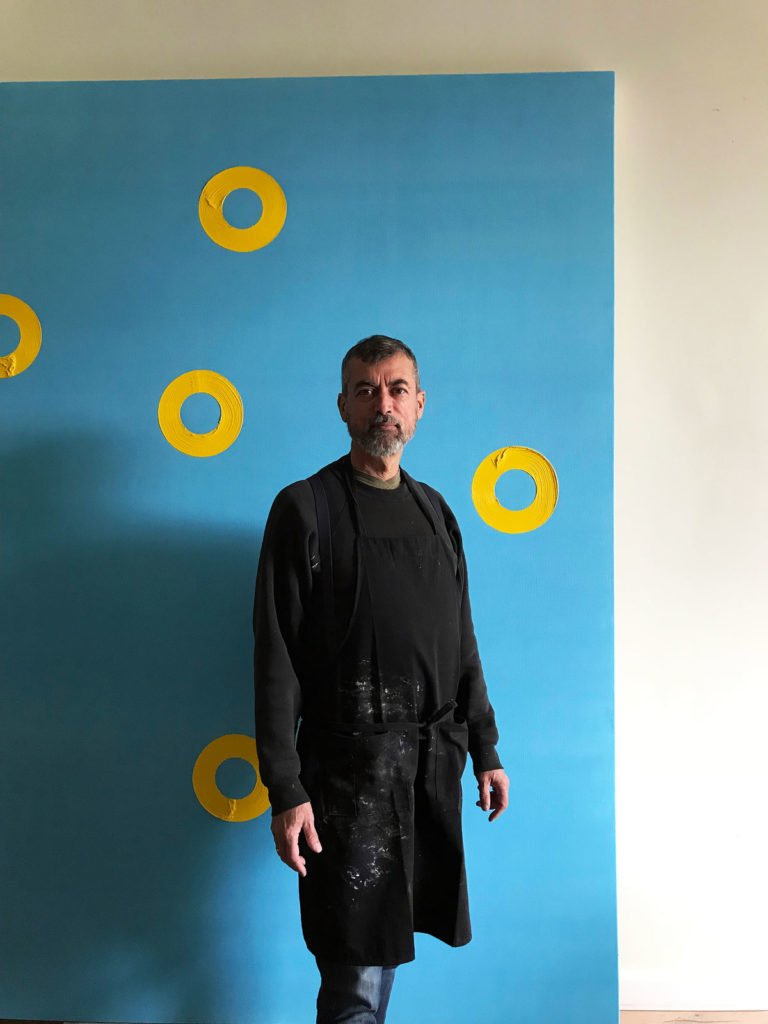 Artist Stephen Andrews in his Toronto studio. Andrews is a winner of the GG's this year. Photo: Aaron Dishy.
Artist Stephen Andrews in his Toronto studio. Andrews is a winner of the GG's this year. Photo: Aaron Dishy.
